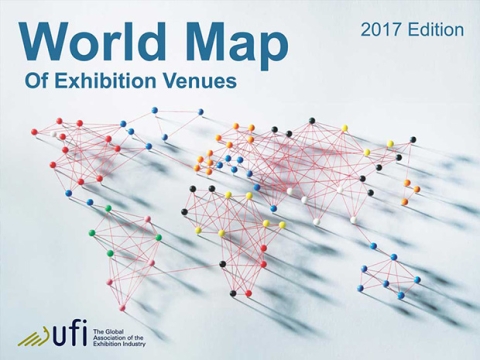UFI’s World Map of Exhibition Venues Data Shows Growth of Global Venue Space

UFI, the Global Association of the Exhibition Industry, has released its full 2017 report on the World Map of Exhibition Venues.
The report analyzes indicators on key regional trends and includes the largest venues for all 28 markets with a total capacity exceeding 200,000 square meters (more than 2 million sq. ft.) of gross indoor exhibition space.
It has been six years since UFI last produced this global exhibition venue census. This year’s release shows a capacity increase in the majority of markets around the world.
According to report data, global venue space has grown by 1.2 percent on average per year since 2011. There are now 1,212 exhibition venues with a total of 34.6 million sq. m. around the world.
The fastest-growing segment is venues offering more than 100,000 sq. m. of exhibition space. Although there are only 61 of these venues globally, making up five percent of the market, there has been a 27 percent increase compared with the past six years.
Venues offering 5,000-20,000 sq. m. of space make up 61 percent of the market, coming in a close second in terms of market growth. The remaining third is medium-size venues, offering 20,000-100,000 sq. m.
While the growth trend is worldwide, the Asia-Pacific region is at the forefront of new development, with more venue space available across Asia-Pacific than in all of North America.
Europe retains its global lead on available venue capacities with 45.4 percent of the global market share, ahead of Asia-Pacific with 23.7 percent and North America with 23.6 percent.
The U.S. remains the market with the most exhibition venue space available (19.8 percent of global capacity), with China (16.6 percent) and Germany (9.3 percent) completing the top three.
These three, plus Italy and France, each offer more than 2,000,000 sq. m. of total gross indoor exhibition space, and taken together, these markets account for almost 60 percent of the total world indoor exhibition space.
“We are pleased to see that in recent years, additional venue space has become available in almost all regions of the world,” said Kai Hattendorf, managing director and CEO of UFI.
He continued, “Venue investments are long-term investments, so these trends underline the positive outlook for the exhibition industry mid- to long-term. In addition to adding new space, many venue operators have also made significant investments to upgrade their existing venue capacities.”
Hattendorf also commented on the quality of the space, adding that in addition to new developments and space expansions, many venues have also made significant investments to upgrade their existing venue capacities.
The 2017 UFI World Map of Exhibition Venues covers markets in countries including Austria, Belgium, Brazil, Canada, China, Czech Republic, Denmark, France, Germany, Greece, India, Italy, Japan, Mexico, Poland, Russia, Singapore, South Africa, South Korea, Spain, Sweden, Switzerland, Thailand, The Netherlands, Turkey, UAE, the U.K. and the U.S.
The report includes data for each region and for the main national markets and includes a list of all venues with a minimum of 100,000 square meters of gross indoor exhibition space.
Download a copy of the report for free HERE.
TSNN.com, sister site to Corporate Event News, supplied information to the report covering more than 400 venues with exhibit space. The searchable TSNN Venue Directory can be found HERE.


Add new comment